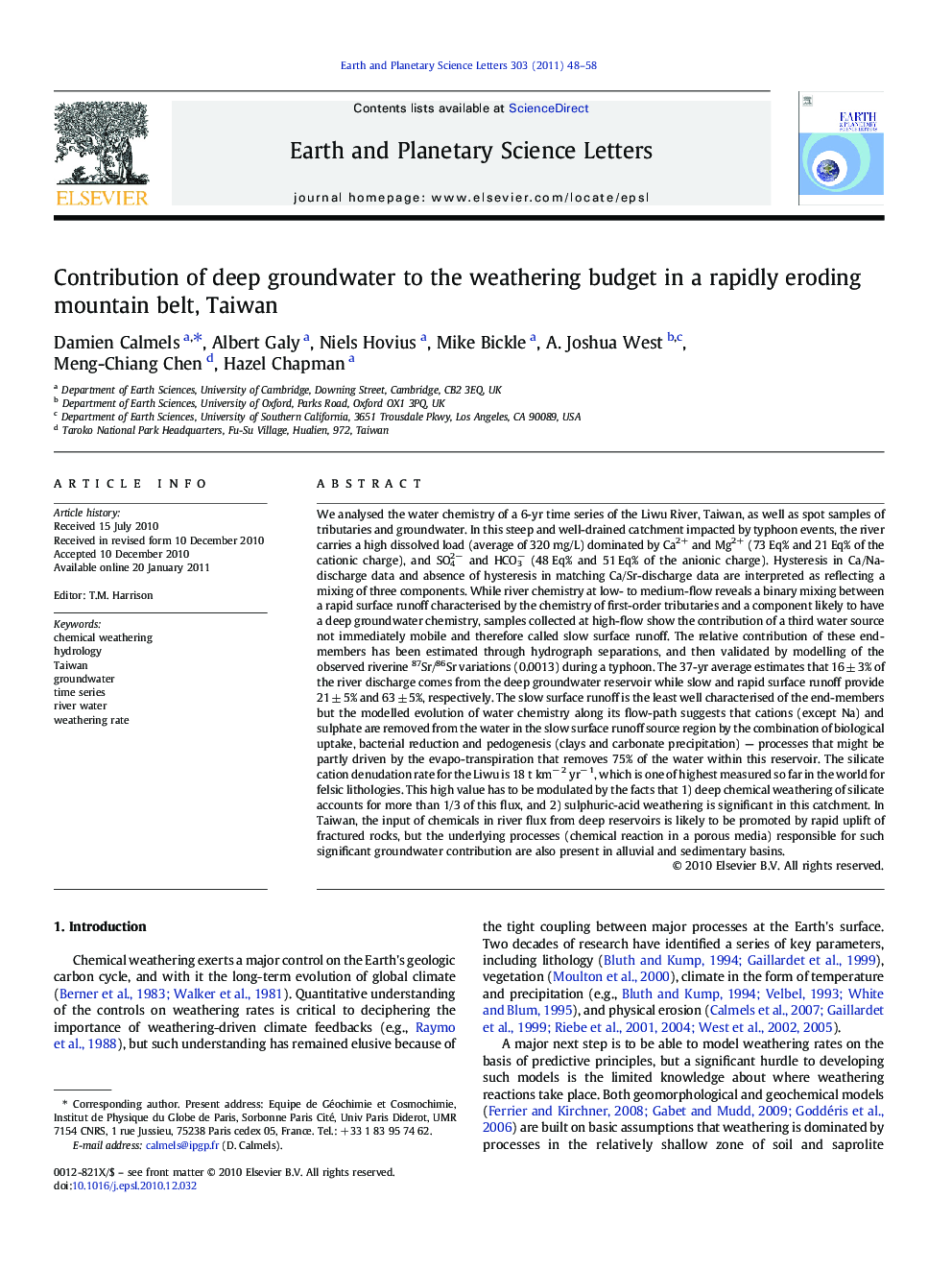| کد مقاله | کد نشریه | سال انتشار | مقاله انگلیسی | نسخه تمام متن |
|---|---|---|---|---|
| 4678078 | 1634834 | 2011 | 11 صفحه PDF | دانلود رایگان |

We analysed the water chemistry of a 6-yr time series of the Liwu River, Taiwan, as well as spot samples of tributaries and groundwater. In this steep and well-drained catchment impacted by typhoon events, the river carries a high dissolved load (average of 320 mg/L) dominated by Ca2+ and Mg2+ (73 Eq% and 21 Eq% of the cationic charge), and SO42− and HCO3− (48 Eq% and 51 Eq% of the anionic charge). Hysteresis in Ca/Na-discharge data and absence of hysteresis in matching Ca/Sr-discharge data are interpreted as reflecting a mixing of three components. While river chemistry at low- to medium-flow reveals a binary mixing between a rapid surface runoff characterised by the chemistry of first-order tributaries and a component likely to have a deep groundwater chemistry, samples collected at high-flow show the contribution of a third water source not immediately mobile and therefore called slow surface runoff. The relative contribution of these end-members has been estimated through hydrograph separations, and then validated by modelling of the observed riverine 87Sr/86Sr variations (0.0013) during a typhoon. The 37-yr average estimates that 16 ± 3% of the river discharge comes from the deep groundwater reservoir while slow and rapid surface runoff provide 21 ± 5% and 63 ± 5%, respectively. The slow surface runoff is the least well characterised of the end-members but the modelled evolution of water chemistry along its flow-path suggests that cations (except Na) and sulphate are removed from the water in the slow surface runoff source region by the combination of biological uptake, bacterial reduction and pedogenesis (clays and carbonate precipitation) — processes that might be partly driven by the evapo-transpiration that removes 75% of the water within this reservoir. The silicate cation denudation rate for the Liwu is 18 t km− 2 yr− 1, which is one of highest measured so far in the world for felsic lithologies. This high value has to be modulated by the facts that 1) deep chemical weathering of silicate accounts for more than 1/3 of this flux, and 2) sulphuric-acid weathering is significant in this catchment. In Taiwan, the input of chemicals in river flux from deep reservoirs is likely to be promoted by rapid uplift of fractured rocks, but the underlying processes (chemical reaction in a porous media) responsible for such significant groundwater contribution are also present in alluvial and sedimentary basins.
Research Highlights
► Chemical survey on a 6-yr time series of water samples from the Liwu river, Taiwan.
► Hydrological mixings explain the temporal variations in river chemistry.
► Silicate denudation rate for the Liwu is one of the highest for felsic lithologies.
► Deep chemical weathering reactions provide 1/3 of the total silicate weathering flux.
► Our study shows the need to incorporate groundwater systems into the critical zone.
Journal: Earth and Planetary Science Letters - Volume 303, Issues 1–2, 15 February 2011, Pages 48–58